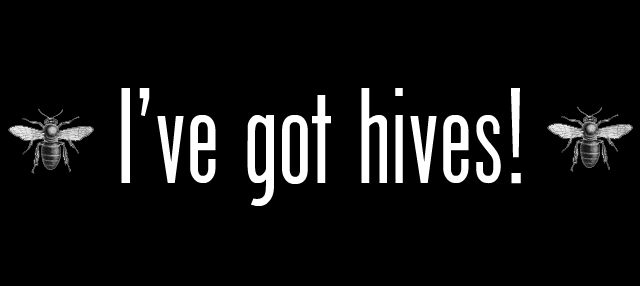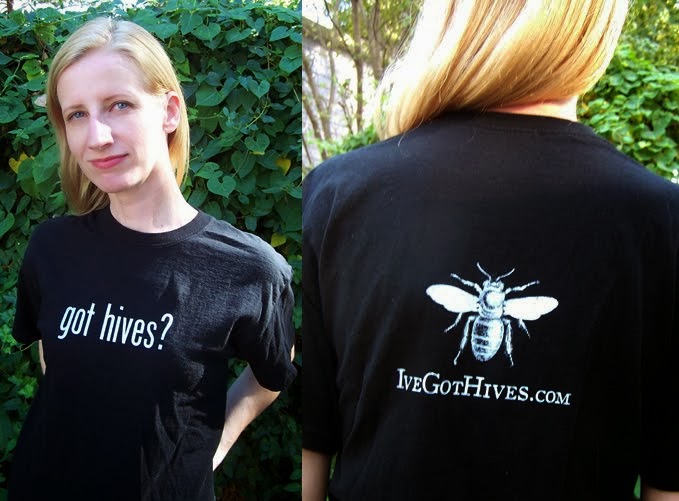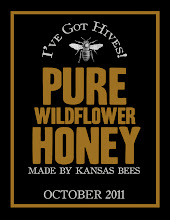There has been a lot of talk lately in the news and, I can only assume, around the proverbial water cooler, about “leaked” government documents and their embarrassing political effects on the federal departments concerned. Many of these have made headlines, and some have not.
Well, a couple of days ago, the Pesticide Action Network of North America got their hands on an internal memo from the Environmental Protection Agency (you know, those folks whose job it is to protect the environment) which shows that the EPA has ignored and even intentionally suppressed the findings of its own scientists regarding neonicotinoid pesticides and their harmful effect on honeybees and other so-called “non-target” pollinators. (Non-target pollinators include bees, wasps and butterflies, which, although not the intended target of an insecticide, are affected by it nonetheless.)
You may recall a previous article of mine entitled Bee Informed, Part 3: The “Mystery” of Colony Collapse Disorder in which I make the case that neonics are largely responsible for CCD, and that countries that have banned the use of these systemic nicotine-based pesticides have seen a reverse in their honeybee population decline. To briefly summarize, this type of pesticide is a toxic chemical containing synthesized nicotine in liquid form that is sprayed on crop seeds (such as corn, canola, sugar beets, soy and wheat) and spreads throughout the vascular system to every part of the mature plant, including nectar and pollen, after the seed has germinated. In theory, this saves farmers the time, money and effort required to spray pesticides on their plants. The type most widely in use in the United States is Clothianidin, manufactured by Bayer Corp, sold under the trade name “Poncho.” It is classified by the EPA as a Category III toxic substance, and a “not likely” human carcinogen. The "Summary Science Statements" published in an EPA Pesticide Fact Sheet on Clothianidin from 2003, submitted to the EPA by Bayer as part of the registration process, state:
“Based upon a battery of acute toxicity studies, Poncho 600 is classified as Toxicity Category III. Clothianidin is classified as a “not likely” human carcinogen. There are no to low concerns and no residual uncertainties with regard to pre- and/or postnatal toxicity from clothianidin, and the FQPA 10X Safety Factor has been removed. However, due to evidence of effects on the rat immune system and that juvenile rats appear to be more susceptible to these effects, and due to the lack of a developmental immunotoxicity study, a 10X database uncertainty factor is applied to all dietary exposure endpoints.
Available data indicate that clothianidin on corn and canola should result in minimal acute toxic risk to birds. However, assessments show that exposure to treated seeds through ingestion may result in chronic toxic risk to non-endangered and endangered small birds (e.g., songbirds) and acute/chronic toxicity risk to non-endangered and endangered mammals. Clothianidin has the potential for toxic chronic exposure to honey bees, as well as other nontarget pollinators, through the translocation of clothianidin residues in nectar and pollen. Clothianidin should not present a direct acute or chronic risk to freshwater and estuarine/marine fish, or a risk to terrestrial or aquatic vascular and nonvascular plants.
The fate and disposition of clothianidin in the environment suggest a compound that is a systemic insecticide that is persistent and mobile, stable to hydrolysis, and has potential to leach to ground water, as well as runoff to surface waters.”
This was back in 2003, when Bayer first registered clothianidin for sale in the U.S., and neonicotinoid pesticides were still a fairly recent development (as was CCD). The damage to birds, rats and other mammals, and honeybees, was postulated but uncertain, and, in a transparently industry-friendly decision, it was still considered an acceptable risk - since it was considered unlikely to have chronic effects on humans. Plus, you know, there was money to be made. Of course, the EPA didn't run any tests themselves - they accepted the results of tests conducted by Bayer Corp's paid scientists. Later in this same report, this paragraph is found:
“Chemical-specific data for assessing human exposures during pesticide handling activities were not submitted to the Agency in support of the registration of clothianidin. Instead, the registrant (Bayer) submitted surrogate studies using the chemicals Oftanol (isofenphos) and Baytan (triadimenol). Bayer Corp. also submitted two exposure assessments which used these seed treatment exposure studies as surrogates for exposure to clothianidin.”
That was apparently good enough for the Environmental Protection Agency. Bayer, the very company that sought to profit from the sale of a toxic substance to be used on food crops, was allowed to perform its own testing to determine health risk to humans, with no oversight or even independent study to confirm or refute its results. Indeed, when strong concerns over mounting evidence of ecological damage done by neonicotinoids was voiced by its own experts, the EPA ignored them completely. Moreover, the EPA felt the company had sufficiently demonstrated the safety of its product by using the results of testing with a completely different chemical in place of the one they intended to sell. The Agency green-lighted its registration without a second thought; birds, bees and endangered mammals be damned. Our environmental watchdog would clearly prefer the life of a corporate lapdog.
Since 2003, scientists at the EPA have conducted some tests in response to the insistent nagging of reality, and what they found contrasted sharply with Bayer Corp's spurious and profit-driven reporting. The EPA scientists essentially rejected these findings, and reiterated their concern about the risk to the North American honeybee population of widespread use of clothianidin and other neonics.
Let's jump forward to the document in question, though, dated November 2, 2010. I won't bore you with the sordid history of the attempts to halt Bayer's sale of neonics since 2003, thwarted largely by the EPA, and justified by ridiculously unscientific field studies such as this one, published in 2007. (This study, written by the Department of Environmental Biology at the University of Guelph, in Ontario, Canada - and funded by Bayer - claims that colonies of honeybees showed no detrimental effects from long-term exposure to clothianidin. The failing of this study lies in the fact that the pesticide was only applied on 2.5 acre plots - a tiny sliver of bees' actual foraging range, as opposed to the enormous, unbroken swaths of farmland planted with neonics in the U.S. In his assessment of this particular study, Colorado beekeeper Tom Theobald aptly noted, “Imagine you're a rancher trying to figure out if a noxious weed is harming your cows. If you plant the weed on two acres and let your cows roam free over 50 acres of lush Montana grass, you're not going to learn much about that weed.”)
In response to Bayer's efforts to expand the use of neonics to mustard and cotton, this most recent memo was written by two scientists at the EPA's Environmental Fate and Effects Division (EFED), ecologist Joseph DeCant and chemist Michael Barrett, and expresses their serious concerns about clothianidin's lethal effects on honeybees. They wrote:
“Clothianidin’s major risk concern is to nontarget insects (that is, honey bees). Clothianidin is a neonicotinoid insecticide that is both persistent and systemic. Acute toxicity studies to honeybees show that clothianidin is highly toxic on both a contact and an oral basis. Although EFED does not conduct RQ based risk assessments on non-target insects, information from standard tests and field studies, as well as incident reports involving other neonicotinoids insecticides (e.g., imidacloprid) suggest the potential for long term toxic risk to honey bees and other beneficial insects. An incident in Germany already illustrated the toxicity of clothianidin to honeybees when allowed to drift off-site from treated seed during planting.
A previous field study (MRID 46907801/46907802) investigated the effects of clothianidin on whole hive parameters and was classified as acceptable. However, after another review of this field study in light of additional information, deficiencies were identified that render the study supplemental. It does not satisfy the guideline 850.3040, and another field study is needed to evaluate the effects of clothianidin on bees through contaminated pollen and nectar. Exposure through contaminated pollen and nectar and potential toxic effects therefore remain an uncertainty for pollinators.
EFED expects adverse effects to bees if clothianidin is allowed to drift from seed planting equipment. Because of this and the uncertainty surrounding the exposure and potential toxicity through contaminated pollen and nectar, EFED is recommending bee precautionary labeling.”
The deficient “previous field study” cited by DeCant and Barrett was, of course, that same Guelph report from 2007, funded by Bayer Corp and used to downplay the risks involved in order to justify the continued use and sale of neonics, specifically on corn. The authors of the memo go on to say:
“Honey Bee Toxicity of Residues on Foliage (850.3030): This study is required for chemicals that have outdoor terrestrial uses in which honeybees will be exposed and exhibit an LD50 <11μg>
Field Test for Pollinators (850.3040): The possibility of toxic exposure to nontarget pollinators through the translocation of clothianidin residues that result from seed treatments has prompted EFED to require field testing (850.3040) that can evaluate the possible chronic exposure to honey bee larvae and queen. In order to fully evaluate the possibility of this toxic effect, a field study should be conducted and the protocol submitted for review by the Agency prior to initiation. Another study had been submitted to satisfy this guideline requirement. While it had originally been classified as acceptable, after recent reevaluation it is classified as supplemental, and a field study is still being needed for a more refined risk assessment.”
Downgrading a study from “acceptable” to “supplemental,” however, doesn't alter the final status of neonicotinoids as safe to use on a huge scale, according to EPA rules. And in the very probable case that the previous statements were too obtuse for whomever the memo was intended, DeCant and Barrett summarize their opinion thusly, as their recommendation for language to be included on the chemical's label:
“This product is toxic to aquatic invertebrates. Do not apply directly to water or to areas where surface water is present or to intertidal areas below the mean high-water mark. Do not contaminate water when cleaning equipment or disposing of equipment washwaters. Do not apply where runoff is likely to occur. Runoff from treated areas may be hazardous to aquatic organisms in neighboring areas. Apply this product only as specified on the label.
This chemical has properties and characteristics associated with chemicals detected in ground water. The use of this chemical in areas where soils are permeable, particularly where the water table is shallow, may result in ground water contamination.
This compound is toxic to birds and mammals. Treated clothianidin seeds exposed on soil surface may be hazardous to birds and mammals. Cover or collect clothianidin seeds spilled during loading.
This compound is toxic to honey bees. The persistence of residues and potential residual toxicity of Clothianidin in nectar and pollen suggests the possibility of chronic toxic risk to honey bee larvae and the eventual instability of the hive.”
It couldn't be clearer than that. And all of the paragraphs that I have quoted are found in the introduction of the memo, before the report even begins. The following 100 pages of the complete document specify risk assessment and set the parameters for field studies that the authors have determined must be conducted in order to determine actual effects, during which time the sale and use of neonics must be suspended.
This is only the latest example of the EPA ignoring and burying the concerns of its own scientists who are in the honest business of trying to fulfill the mandate set out for them, i.e., environmental protection. Which brings us to the obvious question - why would the Environmental Protection Agency continue to allow the use of chemicals which cause such irreparable harm to the environment, favoring pseudo-scientific studies that support the claims of its manufacturer while suppressing reports written by its own scientists warning of environmental damage? Since 2003, corn has been the largest crop in the United States by a huge margin (88 million acres), and in 2009 alone, Bayer made about $262 million from its sale of Clothianidin, the insecticide used to treat corn seeds in the U.S. It doesn't take a great leap of the imagination to understand this relationship. And when asked if the revelation of this document might finally convince the EPA to remove Clothianidin from the market, at least until proper field studies to determine its impact can be conducted, an EPA spokesman authorized to speak on behalf of the Agency replied that the pesticide will retain its registration status and be available again for spring planting. So that's good news... for Bayer Corp.
Sources:
2010 EPA Memo:
DeCant and Barrett, Clothianidin Registration of Prosper T400 Seed Treatment on Mustard Seed (Oilseed and Condiment) and Poncho/Votivo Seed Treatment on Cotton
2007 Bayer-funded Guelph Report:
Cutler and Scott-DuPree, Exposure to Clothianidin Seed-Treated Canola Has No Long-Term Impact on Honey Bees
2003 EPA Clothianidin Pesticide Fact Sheet:
Clothianidin Conditional Registration
(Links to the document files to come.)
Thursday, December 16, 2010
Subscribe to:
Posts (Atom)




